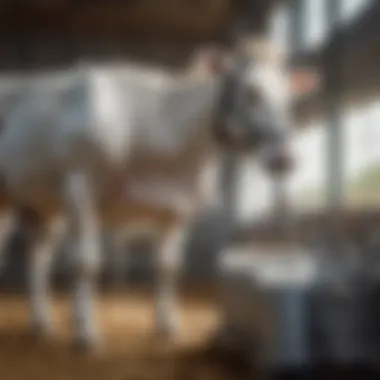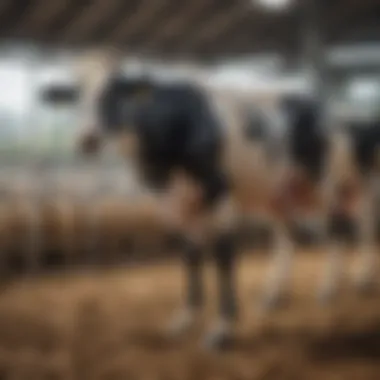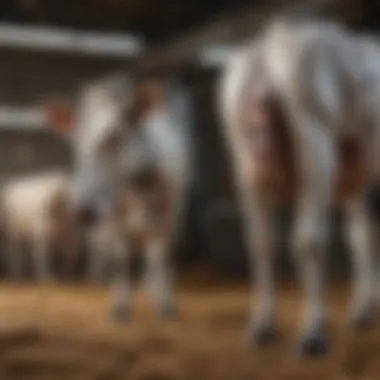GEA Milking Robots: Revolutionizing Dairy Farming


Intro
The dairy industry is undergoing a significant transformation driven by technological advancements. GEA milking robots are at the forefront of these changes, offering innovative solutions for modern dairy farming. These robots not only enhance productivity but also provide a more sustainable approach to milking.
Understanding the role of GEA milking robots in dairy farming requires a closer look at their operational principles and the technological context in which they operate. This exploration will identify the key benefits and challenges farmers face when integrating such technology into their practices. The relevance of these robots extends beyond immediate agricultural benefits; they represent a shift towards greater automation in agriculture as a whole.
Topic Overview
Definition of Key Terms
Before delving deeper, it’s essential to clarify some key terms.
- Milking Robot: An automated system designed for milking cows without the need for manual intervention.
- Automation in Agriculture: The use of control systems for operating equipment in agriculture, including machinery, processes in factories, boilers, and heat treating ovens, switches, telecommunications, and other applications.
Relevance in Agriculture, Horticulture, and Agronomy
GEA milking robots play an important role in diverse fields of agriculture. Their ability to operate continuously and their efficiency in managing cows’ health and production contribute to higher yields. Additionally, reduced labor costs and improved milk quality are noteworthy benefits that appeal to farmers today. Integrating such technology allows farmers to focus on other aspects of business management and sustainability.
Current Trends and Innovations
Recent Advancements in the Field
The dairy industry has seen several advancements in GEA milking robots in recent years. Notable improvements include:
- Enhanced sensors for better cow identification and health monitoring.
- Improved algorithms for optimizing milking schedules.
- Integration with farm management systems for real-time data analysis.
Emerging Technologies and Practices
In tandem with GEA milking robots, other technologies are emerging within dairy farming. Technologies such as precision farming techniques and data analytics are gaining traction, supporting farmers in making informed decisions. These strategies ensure sustainable practices while maximizing production and profit.
Practical Applications
Step-by-Step Guides or How-Tos
Integrating GEA milking robots into a dairy farming operation can seem daunting. However, following these steps can smooth the process:
- Assessment: Analyze your current milking setup to identify areas for improvement.
- Education: Learn about the capabilities and requirements of GEA milking robots.
- Planning: Develop a plan for integration that includes layout adjustments and technical support.
- Implementation: Install the system and conduct a trial run to familiarize the animals and staff with the new technology.
- Monitoring: Continuously monitor the robots' performance and cow health to optimize results.
Tips and Best Practices for Implementation
To maximize the benefits of GEA milking robots, consider the following:
- Maintain regular software updates for optimal performance.
- Train staff on the system and its functionalities for effective management.
- Analyze performance data frequently to make necessary adjustments.
These systems are designed to adapt to the unique needs of the dairy farm, ensuring flexibility and efficiency in operations.
In summation, GEA milking robots are revolutionizing modern dairy farming. By understanding key concepts and exploring trends, farmers can leverage this technology for improved productivity and sustainability.
Foreword to GEA Milking Robots
The introduction of GEA milking robots represents a significant advancement in the agricultural sector. These machines are not merely tools; they redefine the operational framework of dairy farming. With a push towards automation, GEA stands out in delivering efficient solutions that cater to the complex needs of modern dairy operations.
This section will explore the definition of milking robots, setting the stage for a deeper understanding of their role and function in dairy farming. It will also provide an overview of GEA's standing as a leader in dairy technology, showcasing the innovative capabilities and reliability of its products that add immense value to farming practices.
Defining Milking Robots
Milking robots are automated systems designed to perform milking tasks with minimal human intervention. They utilize advanced technology to identify, attach, and milk cows efficiently. These machines integrate various components such as sensors, automated arms, and software systems that oversee the milking process. The result is increased efficiency, reduced labor costs, and improved animal welfare.
In practical terms, a milking robot attracts a cow and leverages sensors to recognize the individual animal. This ability allows for tailored milking procedures that can be adjusted based on each cow’s health and productivity levels. Furthermore, the robot captures data regarding milk yield and cows’ health indicators, which can be vital for monitoring herd performance and making informed management decisions.


Overview of GEA as a Leader in Dairy Technology
GEA has emerged as a prominent player in the dairy technology sector, known for its relentless innovation and commitment to quality. The company's portfolio includes a variety of automated systems, with milking robots being a flagship product. GEA develops these robots with a focus on enhancing both operational efficiency and animal comfort.
A cornerstone of GEA's success lies in its research and development initiatives, which enable the company to introduce cutting-edge technologies into the dairy farming landscape. GEA milking robots are equipped with smart features that support farmers in managing their operations more effectively. For example, through real-time data analytics and cloud-based monitoring systems, farmers can access critical information about their cows’ health and performance anywhere and at any time.
Additionally, GEA's emphasis on sustainability aligns closely with the modern demands of the dairy industry. By automating the milking process, GEA helps farmers reduce waste and improve resource management, contributing to environmentally responsible practices.
"Automation not only streamlines the milking process but also elevates the standard of care provided to livestock."
In summary, understanding GEA milking robots is essential for grasping the transformation currently happening in dairy farming. With GEA leading the way, the integration of technology into traditional agricultural practices paves the path for more productive and sustainable farming.
Technological Innovations in Milking Robots
Technological innovations in milking robots represent a significant evolution in modern dairy farming. These advancements not only increase efficiency but also enhance the overall management of dairy operations. As the industry faces challenges such as labor shortages and the demand for higher productivity, understanding these innovations becomes crucial for farmers looking to stay competitive.
Advanced Milking Techniques
GEA milking robots employ advanced milking techniques that optimize the milking process. These techniques include the use of sensors to monitor various factors during milking, such as udder health and milk yield. By using real-time data, the robots can adapt their approach to each cow’s needs. This personalization improves milk production and ensures the well-being of the livestock. In addition, robotic systems reduce stress on cows during milking, resulting in better milk quality.
Furthermore, automated milking reduces the risk of injury for staff while milking. Unlike traditional methods, the robots handle all tasks in a gentle, efficient manner. This reduces the need for repeated handling of cows, allowing them to remain calm, which is beneficial for both animal welfare and milk quality.
Automation and Control Systems
The integration of automation and control systems enhances the performance of GEA milking robots. These systems are designed to provide farmers with complete control over the milking process. They allow for scheduling, monitoring, and adjustments without the need for manual intervention.
For instance, GEA offers robust software solutions that can track milking routines, identify problem areas, and report anomalies. This level of oversight helps to streamline operations and manage the farm more effectively. As a result, farmers can easily track the milking process of each cow, leading to improved herd management.
Automation of routine tasks leads to significant labor savings. With fewer workers needed for milking, dairy farms can allocate resources to other important areas, such as herd health and nutrition management.
Data Collection and Analysis Capabilities
Data collection and analysis capabilities are key strengths of GEA milking robots. These machines are equipped with advanced technologies that gather extensive data on milking performance, cow health, and overall farm productivity.
"The use of data analytics in dairy farming can drive improvements in both efficiency and profitability."
Farmers can access this data through user-friendly analytics platforms, enabling them to make informed decisions. For example, monitoring developments such as milk production patterns and cow behavior can highlight trends that require attention. This proactive approach to herd management can significantly increase productivity.
Operational Efficiency of GEA Milking Robots
Operational efficiency is a critical aspect of any dairy farming operation. When it comes to GEA milking robots, the focus on efficiency not only affects the bottom line but also influences the overall productivity of the dairy farm. These robots offer distinct advantages in terms of precision, speed, and consistency, which directly help in maximizing milk production and improving farm management. Understanding the operational efficiency of GEA milking robots allows farmers to assess their investment from multiple angles, including financial return, labor requirements, and animal welfare.
Impact on Milk Production Levels
GEA milking robots significantly enhance milk production levels. By employing precise milking techniques, the robots can optimize the milking process for each cow individually. This customization ensures that each animal is milked at the right time and with the right technique, leading to a marked increase in daily yield. Studies have shown that farms using GEA robots often see a rise in milk output by as much as 15 to 20 percent compared to traditional methods.
Essentially, these robots allow for more frequent milking without sacrificing the health of the cows, leading to improved lactation cycles.
Labor Savings and Workforce Management
Labor savings are another crucial benefit of GEA milking robots. By automating the milking process, farms can operate with fewer hands. This reduction in labor needs does not mean a compromise in quality or care. Instead, operators can redirect their workforce efforts toward other critical areas of farm management, such as animal health monitoring or herd nutrition. Moreover, the need for skilled labor can be diminished, as operating these robots requires technical know-how rather than extensive milking experience.
This shift enables farms not only to reduce their operational costs but also to better allocate human resources more effectively.
Consistency and Cow Comfort
Consistency in milking routines is essential for cow comfort and overall herd health. GEA milking robots provide uniformity in the milking process, which can lead to less stress for the cows. When cows are milked consistently, they experience fewer fluctuations in milk production and better overall health. Moreover, the design of the GEA robots is focused on animal welfare. They are built to minimize discomfort and provide a calm environment during milking.
The robots allow for a more gentle approach, reducing the risk of injury and increasing overall satisfaction for the cows while enhancing their productivity.
"Automation in farming doesn’t just improve efficiency, it enhances the quality of life for both cows and farmers."
This dual emphasis on productivity and care solidifies the position of GEA milking robots as essential tools in modern dairy farming.
Benefits of Implementing GEA Milking Robots


The adoption of GEA milking robots within the dairy farming sector presents significant advantages that merit thorough exploration. These systems are at the intersection of technology and agriculture, revolutionizing milking practices while addressing various operational challenges. The benefits extend beyond enhanced production capabilities; they encapsulate advancements in data management, labor efficiency, and sustainability. Understanding these aspects can guide farmers and stakeholders in evaluating the transition to robotic milking technology.
Increased Productivity
Increased productivity is one of the most compelling reasons for implementing GEA milking robots. Employing these machines enables farms to maintain higher milk production levels with greater consistency. The automation of milking frees up time for workers, allowing them to focus on other essential tasks on the farm. Moreover, the robots can operate around the clock, providing multiple milking sessions per day compared to traditional methods. This leads to more milk collected daily, enhancing overall operational output.
The robots also integrate advanced monitoring systems that optimize machine performance and monitor cow health. Real-time data collection ensures that farmers can quickly address any issues concerning animal welfare, thus preventing declines in milk yield due to health problems. By investing in GEA milking robots, dairy operators can expect a notable rise in productivity levels, optimizing their resource utilization and maximizing profits.
Enhanced Data Insights for Farm Management
Data insights provided by GEA milking robots play a crucial role in modern dairy farm management. These robots are equipped with sophisticated sensors that collect various data points during milking, such as milk yield, cow behavior, and udder health. This information contributes to a comprehensive understanding of the herd’s dynamics, enabling farmers to make informed decisions.
Farm managers can utilize these insights to track individual cow performance over time. They can analyze trends in milk production, understand feeding needs, and identify any health changes in their livestock. Furthermore, predictive analytics can be utilized to optimize milking schedules and to improve feeding strategies. With timely interventions, farmers can enhance both animal well-being and productivity, leading to better resource management overall.
Sustainability and Environmental Considerations
The integration of GEA milking robots also aligns with sustainability goals in the agricultural sector. Traditional dairy farms may face challenges like waste management and energy consumption. Robotic systems can mitigate these issues through efficient resource utilization. For example, precise milking reduces the chances of over-milking and minimizes waste.
Additionally, GEA milking robots often come equipped with energy-efficient technology and sustainable practices. The robots can help reduce the overall carbon footprint by optimizing energy use and diminishing water wastage. By implementing these technologies, dairy farms not only improve their operational efficiency but also adhere to environmental regulations and contribute to a more sustainable agricultural sector.
"The shift toward GEA milking robots presents a strategic advantage by merging agricultural productivity with sustainable practices."
In summary, the implementation of GEA milking robots offers several pivotal benefits. Increased productivity, enhanced data insights, and sustainability measures work together to transform dairy farming into a more efficient and environmentally friendly operation. These factors should not be overlooked by those considering modernization in their farming practices.
Challenges and Considerations of Milking Robots
The integration of GEA milking robots in dairy farming presents several challenges and considerations that must be addressed. Understanding these factors is crucial for farmers looking to implement such advanced technology in their operations. The primary concerns often revolve around initial costs, ongoing maintenance, and the adaptability of traditional practices.
Initial Cost and Investment Analysis
One of the most prominent challenges of adopting GEA milking robots is the initial financial investment required. The costs associated with purchasing and installing robotic milking systems can be substantial. On average, farms can expect to invest hundreds of thousands of dollars, depending on the size of the operation and the specific technology adopted.
Farmers need to conduct a thorough investment analysis to weigh these costs against potential benefits. This involves evaluating the return on investment (ROI) over time. Key factors in this calculation include:
- Increase in Milk Production: Enhanced milking efficiency can lead to higher overall yield.
- Labor Cost Reduction: Robots can significantly reduce the need for manual labor, creating savings in long-term operational costs.
- Improved Cow Health: Regular monitoring of cows can result in better health outcomes, ultimately reducing veterinary expenses.
A sound financial strategy includes looking at financing options and governmental subsidies that may help ease the burden of initial costs.
Technical Maintenance and Support
Once GEA milking robots are in operation, technical maintenance becomes a pivotal aspect of running a successful dairy operation. Regular servicing is key to ensuring the technology functions smoothly. This reliability is essential since any downtime can directly impact production and income.
Farmers must plan for:
- Training Programs: Adequate training for staff on how to operate and troubleshoot robots is vital.
- Access to Qualified Technicians: Establishing relationships with service providers for timely repairs and maintenance support can minimize disruptions.
- Spare Parts Inventory: Keeping essential spare parts on hand can prepare farms for quick fixes, ultimately ensuring operational continuity.
Effective maintenance management is critical in safeguarding investments and maximizing operational efficiency.
Adaptability of Traditional Farming Practices
The integration of GEA milking robots often requires a cultural and operational shift for traditional dairy farms. Many farmers are accustomed to their established workflows and may find resistance to changing these. However, adaptability is crucial for realizing the full benefits of robotic milking.
Factors to consider include:
- Operational Adjustments: Farms may need to rethink scheduling, herd management, and workflow efficiency to suit robotic systems.
- Philosophical Shifts: Farmers must embrace technology as an aid rather than a replacement, understanding that it enhances their ability to manage and care for their livestock.
- Support from Educational Resources: Engagement with agricultural extension services or workshops can provide valuable insights into adapting workflows.
Integrating GEA Milking Robots into Existing Operations
Integrating GEA milking robots into existing dairy operations is a crucial step for farms that wish to adopt modern technology. The process involves not only the installation of the equipment but also an evaluation of the current infrastructure, workforce capabilities, and operational practices. Successful integration can lead to improved efficiency, increased milk production, and enhanced animal welfare. Understanding how to effectively bring these automated systems into operation sets the foundation for the future of dairy farming.


Assessing Farm Readiness for Automation
Before incorporating GEA milking robots, it is essential to assess whether the farm is ready for automation. This includes evaluating the existing milking process, facilities, and herd management practices. Key factors to consider include:
- Infrastructure: Ensure that the barn leading to the milking robots is designed to accommodate them. Adequate space for the machines and proper layout for cow flow is critical.
- Herd Size and Composition: Determine if the current herd is compatible with automated milking systems. Ideally, a herd that is calm and accustomed to handling will ease the transition.
- Technical Knowledge: Evaluate the existing staff’s familiarity with technology. Those who are comfortable with basic software and mechanical operations will adapt better.
An initial audit can help identify gaps and areas for improvement. Farms should prepare for changes in management styles and operational culture as well.
Training Staff and Enhancing Skill Sets
Training staff is an integral part of the integration process. Employees must feel confident in operating and maintaining the new milking robots. Training should focus on several areas:
- Hands-On Training: Practical sessions on how to operate the robots effectively will build confidence and competence among staff.
- Troubleshooting: Equip the team with skills to identify and resolve common problems that may arise during operation.
- Data Utilization: Help staff understand how to interpret data collected by the robots. Knowledge of data will be essential for making informed management decisions.
Regular workshops and refresher courses can ensure that the staff keeps up to date with any new features or functions as technologies evolve. This ongoing education fosters an environment of continuous improvement.
Phased Implementation Strategies
Phased implementation allows farms to adopt GEA milking robots gradually. This strategy can minimize disruption and allow time to adjust operations effectively. Consider the following steps:
- Pilot Program: Start with a smaller section of the herd. This can help identify potential issues without the risk of overwhelming the entire system.
- Gradual Scaling: Based on the results from the pilot program, gradually expand the use of robots across the herd. Monitor performance and make iterative adjustments.
- Feedback Mechanisms: Encourage ongoing feedback from staff during the initial implementation phases. This input is invaluable for refining processes and ensuring that team members remain engaged.
Implementing robots in stages can empower farm operators to address challenges systematically, ultimately leading to smoother transitions and more sustainable technology adoption.
Integrating GEA milking robots requires comprehensive assessment, training, and a gradual implementation strategy to ensure lasting benefits for dairy operations.
Future Trends in GEA Milking Technology
Understanding the future trends in GEA milking technology is essential for stakeholders in the dairy industry. As the agricultural landscape shifts towards greater efficiency and sustainability, GEA's innovations will play a crucial role in shaping the next generation of dairy farming. This section examines the upcoming developments, their integration with smart farming practices, and global market trends that farmers must consider.
Innovations on the Horizon
The advancement of GEA milking technology centers around innovations that could revolutionize dairy farming processes. New features include enhanced automation capabilities, which allow for more precise milking operations. A key focus is on artificial intelligence. By employing AI to monitor cow health and optimize milking schedules, GEA aims to increase productivity significantly.
Furthermore, the introduction of real-time data analytics will enable farmers to access critical operational insights on their devices. These insights will improve decision-making regarding herd management, feeding practices, and overall farm productivity.
"Technological advancements in the dairy sector will focus extensively on sustainability and efficiency, driving farms toward a more automated future."
Integration with Smart Farming Practices
The incorporation of GEA milking robots into smart farming practices represents a significant shift in dairy management. Smart farming involves using technology to monitor and control farming operations. With GEA's advanced systems, farmers can seamlessly connect their milking robots to a network of IoT devices. This integration will facilitate automated monitoring of environmental conditions, allowing for optimized production environments.
Moreover, connectivity will enhance herd health monitoring. By utilizing sensors, farmers can receive alerts about individual cow health and behavior changes. This responsiveness can lead to quicker interventions, promoting better animal welfare and reducing losses in production.
Global Market Trends and Adaptations
As dairy farming evolves globally, several market trends emerge that affect the adoption of GEA milking robots. First is the increasing demand for high-quality, sustainably produced dairy products. Consumers are keen on transparency regarding sourcing and production methods. In response, dairy farmers must adapt their operations to meet these expectations.
Additionally, regions with labor shortages are turning to automation as a viable solution. Countries where traditional farming practices dominate are gradually recognizing the advantages of investing in milking technology. This shift indicates a promising trend for GEA as they continue to export innovative solutions worldwide.
Finale
In summarizing the extensive analysis of GEA milking robots, it is crucial to recognize the profound impact they have on modern dairy farming. Their implementation showcases a significant shift in agricultural practices, driven by technology and the need for efficiency. The benefits and considerations outlined in this article highlight why these milking robots are not only a transient trend but a stable evolution in dairy management.
Summarizing Key Insights
The key insights into the GEA milking robots are numerous and compelling. These machines harness advanced technologies to streamline the milking process, increase productivity, and ensure cow comfort. Some notable points include:
- Enhanced Efficiency: GEA milking robots have proven to optimize labor costs while maximizing output. This is especially relevant in environments where manual labor is scarce or expensive.
- Data-Driven Management: Farms utilizing these robots can analyze comprehensive data that informs decision-making processes. This analytical capacity allows for tailored herd management strategies, improving both health and yield.
- Sustainability: The use of milking robots contributes to environmental sustainability. Reduced labor intensity and more precise resource allocation lower emissions and waste.
These points illustrate the multi-faceted benefits that GEA milking robots bring to dairy operations, cementing their roles in efficient and innovative farming practices.
Future Implications for the Dairy Industry
The future of dairy farming with the implementation of GEA milking robots appears promising. As technology continues to advance, several implications can be anticipated:
- Increased Adoption: As costs decrease and the technology becomes more accessible, more farmers will adopt milking robots. This will lead to a revolution in traditional practices and workflows.
- Integration with Smart Agriculture: The trend towards precision farming supports the seamless integration of GEA milking robots with other smart farming technologies. This synergy can lead to greater overall efficiency and productivity.
- Policy and Economic Adaptation: The rise of automated solutions like GEA robots will require adaptations in policies and economic frameworks to ensure support and sustainability within the agricultural sector.



